Geometry Morphology and Distribution Characteristics of Permanent Gullies in the Greater and Lesser Khingan Mountains Forest Region of China
Abstract
:1. Introduction
2. Materials and Methods
2.1. Study Area
2.2. Methodology for Field Survey of Gully
3. Results
3.1. General Characteristics of Gully Morphology
3.2. Gully Morphology Distribution Characteristics
3.3. Topographical Distribution
3.4. Gully Volume Estimation
4. Discussion
4.1. The Uniqueness of Gully Morphology in the Greater and Lesser Khingan Mountains
4.2. Topographic Distribution Pattern
4.3. Estimation Model for Gully Volume
4.4. Significance and Limitation of This Study
5. Conclusions
Author Contributions
Funding
Institutional Review Board Statement
Informed Consent Statement
Data Availability Statement
Conflicts of Interest
References
- Rahmati, O.; Tahmasebipour, N.; Haghizadeh, A.; Pourghasemi, H.R.; Feizizadeh, B. Evaluating the influence of geo-environmental factors on gully erosion in a semi-arid region of Iran: An integrated framework. Sci. Total Environ. 2017, 579, 913–927. [Google Scholar] [CrossRef] [PubMed]
- Wu, L.; Liu, X.; Ma, X. Impacts of Grain for Green project on spatiotemporal variations of soil erosion in a typical watershed of Chinese Loess hilly and gully region. Fresenius Environ. Bull. 2016, 25, 4506–4516. [Google Scholar]
- Tsegaye, B. Effect of land use and land cover changes on soil erosion in Ethiopia. Int. J. Agric. Sci. Food Technol. 2019, 5, 26–34. [Google Scholar]
- Guo, X.; Shao, Q. Spatial pattern of soil erosion drivers and the contribution rate of human activities on the Loess Plateau from 2000 to 2015: A boundary line from northeast to southwest. Remote Sens. 2019, 11, 2429. [Google Scholar] [CrossRef] [Green Version]
- Wang, X.; Zhao, X.; Zhang, Z.; Yi, L.; Zuo, L.; Wen, Q.; Liu, F.; Xu, J.; Hu, S.; Liu, B. Assessment of soil erosion change and its relationships with land use/cover change in China from the end of the 1980s to 2010. Catena 2016, 137, 256–268. [Google Scholar] [CrossRef]
- Mounirou, L.A.; Yonaba, R.; Tazen, F.; Ayele, G.T.; Yaseen, Z.M.; Karambiri, H.; Yacouba, H. Soil erosion across scales: Assessing its sources of variation in Sahelian landscapes under semi-arid climate. Land 2022, 11, 2302. [Google Scholar] [CrossRef]
- Mounirou, L.A.; Yonaba, R.; Koïta, M.; Paturel, J.-E.; Mahé, G.; Yacouba, H.; Karambiri, H. Hydrologic similarity: Dimensionless runoff indices across scales in a semi-arid catchment. J. Arid Environ. 2021, 193, 104590. [Google Scholar] [CrossRef]
- Valentin, C.; Poesen, J.; Li, Y. Gully erosion: Impacts, factors and control. Catena 2005, 63, 132–153. [Google Scholar] [CrossRef]
- Fenli, Z.; Ximeng, X.; Chao, Q. A review of gully erosion process research. Nongye Jixie Xuebao/Trans. Chin. Soc. Agric. Mach. 2016, 47, 48–59+116. [Google Scholar]
- Li, M.; Li, T.; Zhu, L.; Meadows, M.E.; Zhu, W.; Zhang, S. Effect of land use change on gully erosion density in the black soil region of Northeast China from 1965 to 2015: A case study of the Kedong County. Front. Environ. Sci. 2021, 9, 652933. [Google Scholar] [CrossRef]
- Su, Z.; Xiong, D.; Dong, Y.; Yang, D.; Zhang, S.; Zhang, B.; Zheng, X.; Zhang, J.; Shi, L. Influence of bare soil and cultivated land use types upstream of a bank gully on soil erosion rates and energy consumption for different gully erosion zones in the dry-hot valley region, Southwest China. Nat. Hazards 2015, 79, 183–202. [Google Scholar] [CrossRef]
- Xu, Q.; Chen, W.; Zhao, K.; Zhou, X.; Du, P.; Guo, C.; Ju, Y.; Pu, C. Effects of land-use management on soil erosion: A case study in a typical watershed of the hilly and gully region on the Loess Plateau of China. Catena 2021, 206, 105551. [Google Scholar] [CrossRef]
- Li, H.; Cruse, R.M.; Liu, X.; Zhang, X. Effects of topography and land use change on gully development in typical mollisol region of Northeast China. Chin. Geogr. Sci. 2016, 26, 779–788. [Google Scholar] [CrossRef] [Green Version]
- Zhang, G.; Yang, Y.; Liu, Y.; Wang, Z. Advances and prospects of soil erosion research in the black soil region of northeast China. J. Soil Water Conserv. 2022, 36, 1–12. [Google Scholar]
- Wang, R.; Zhang, S.; Pu, L.; Yang, J.; Yang, C.; Chen, J.; Guan, C.; Wang, Q.; Chen, D.; Fu, B. Gully erosion mapping and monitoring at multiple scales based on multi-source remote sensing data of the Sancha River Catchment, Northeast China. ISPRS Int. J. Geo-Inf. 2016, 5, 200. [Google Scholar] [CrossRef] [Green Version]
- Zhang, S.; Li, F.; Li, T.; Yang, J.; Bu, K.; Chang, L.; Wang, W.; Yan, Y. Remote sensing monitoring of gullies on a regional scale: A case study of Kebai region in Heilongjiang Province, China. Chin. Geogr. Sci. 2015, 25, 602–611. [Google Scholar] [CrossRef]
- Zhang, T.; Liu, G.; Duan, X.; Wilson, G. Spatial distribution and morphologic characteristics of gullies in the Black Soil Region of Northeast China: Hebei watershed. Phys. Geogr. 2016, 37, 228–250. [Google Scholar] [CrossRef]
- Wang, R.; Sun, H.; Yang, J.; Zhang, S.; Fu, H.; Wang, N.; Liu, Q. Quantitative evaluation of gully erosion using multitemporal UAV data in the southern black soil region of Northeast China: A case study. Remote Sens. 2022, 14, 1479. [Google Scholar] [CrossRef]
- Li, Z.; Qi, Z.; Qin, W.; Chen, C.; Wu, K.; Feng, T. Gully volume estimation model using high-resolution satellite imaging in mountainous and hilly regions with black soil of Northeast China. Trans. Chin. Soc. Agric. Eng. 2021, 37, 122–130. [Google Scholar]
- Osorio, D.R.; Giraldo, S.; Mazuera, E.; Burbano, A.; Figueredo, E. Beyond Visualization: Remote Sensing Applications in Prehispanic Settlements to Understand Ancient Anthropogenic Land Use and Occupation in the Sierra Nevada de Santa Marta, Colombia. Lat. Am. Antiq. 2023, 1–21. [Google Scholar] [CrossRef]
- Zhang, X.; Liu, X. Current scenario of gully erosion and its control strategy in Mollisols areas of Northeast China. Trans. Chin. Soc. Agric. Eng 2021, 37, 320–326. [Google Scholar]
- Yu, X.; Changshun, Z.; Jie, X. Areas benefiting from water conservation in key ecological function areas in China. J. Resour. Ecol. 2015, 6, 375–385. [Google Scholar] [CrossRef]
- Wang, J.; Zhang, Y.; Deng, J.; Yu, S.; Zhao, Y. Long-term gully erosion and its response to human intervention in the tableland region of the chinese loess plateau. Remote Sens. 2021, 13, 5053. [Google Scholar] [CrossRef]
- Anderson, R.L.; Rowntree, K.M.; Le Roux, J.J. An interrogation of research on the influence of rainfall on gully erosion. Catena 2021, 206, 105482. [Google Scholar] [CrossRef]
- Bradford, J.M.; Piest, R.F. Erosional development of valley-bottom gullies in the upper midwestern United States. In Thresholds in Geomorphology; Routledge: Abingdon-on-Thames, UK, 2020; pp. 75–101. [Google Scholar]
- Achten, W.; Dondeyne, S.; Mugogo, S.; Kafriti, E.; Poesen, J.; Deckers, J.A.; Muys, B. Gully erosion in South Eastern Tanzania: Spatial distribution and topographic thresholds. Z. Geomorphol. 2008, 52, 225–235. [Google Scholar] [CrossRef]
- Zhang, S.; Han, X.; Cruse, R.M.; Zhang, X.; Hu, W.; Yan, Y.; Guo, M. Morphological characteristics and influencing factors of permanent gully and its contribution to regional soil loss based on a field investigation of 393 km2 in Mollisols region of northeast China. Catena 2022, 217, 106467. [Google Scholar] [CrossRef]
- Li, Z.; Zhang, Y.; Shang, G.; Qi, F.; Ma, Q.; Li, Y. Characterizing gully cross section and modelling gully volume in hilly loess region of western Shanxi Province. Trans. Chin. Soc. Agric. Eng. 2018, 34, 152–159. [Google Scholar]
- Dong, Y.F.; Xiong, D.H.; Su, Z.A.; Li, J.J.; Yang, D.; Zhai, J.; Lu, X.N.; Liu, G.C.; Shi, L.T. Critical topographic threshold of gully erosion in Yuanmou Dry-hot Valley in Southwestern China. Phys. Geogr. 2013, 34, 50–59. [Google Scholar] [CrossRef]
- Yibeltal, M.; Tsunekawa, A.; Haregeweyn, N.; Adgo, E.; Meshesha, D.T.; Masunaga, T.; Tsubo, M.; Billi, P.; Ebabu, K.; Fenta, A.A. Morphological characteristics and topographic thresholds of gullies in different agro-ecological environments. Geomorphology 2019, 341, 15–27. [Google Scholar] [CrossRef]
- Maerker, M.; Quénéhervé, G.; Bachofer, F.; Mori, S. A simple DEM assessment procedure for gully system analysis in the Lake Manyara area, northern Tanzania. Nat. Hazards 2015, 79, 235–253. [Google Scholar] [CrossRef]
- Han, G.; Zhang, G.; You, L.; Wang, Y.; Yang, L.; Yang, J.; Zhou, L.; Yuan, M.; Zou, X.; Cheng, H. Deflated rims along the Xiangshui River on the Xiliaohe Plain, Northeast China: A case of active fluvial–aeolian interactions. Geomorphology 2016, 257, 47–56. [Google Scholar] [CrossRef]
- Wu, H.; Xu, X.; Zheng, F.; Qin, C.; He, X. Gully morphological characteristics in the loess hilly-gully region based on 3D laser scanning technique. Earth Surf. Process. Landf. 2018, 43, 1701–1710. [Google Scholar] [CrossRef]
- Li, Z.; Zhang, Y.; Zhu, Q.; Yang, S.; Li, H.; Ma, H. A gully erosion assessment model for the Chinese Loess Plateau based on changes in gully length and area. Catena 2017, 148, 195–203. [Google Scholar] [CrossRef]
- Vanmaercke, M.; Panagos, P.; Vanwalleghem, T.; Hayas, A.; Foerster, S.; Borrelli, P.; Rossi, M.; Torri, D.; Casali, J.; Borselli, L. Measuring, modelling and managing gully erosion at large scales: A state of the art. Earth-Sci. Rev. 2021, 218, 103637. [Google Scholar] [CrossRef]
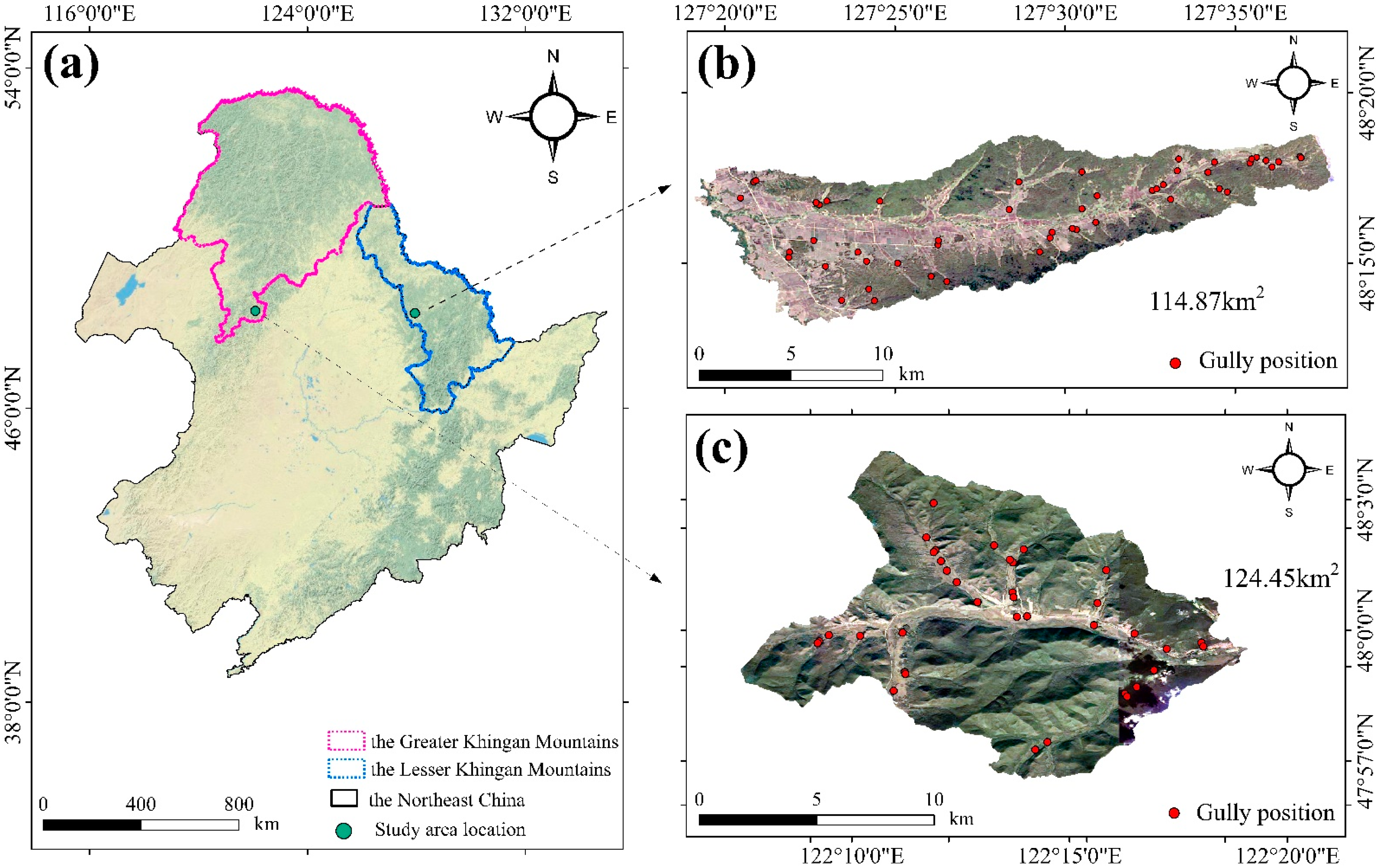
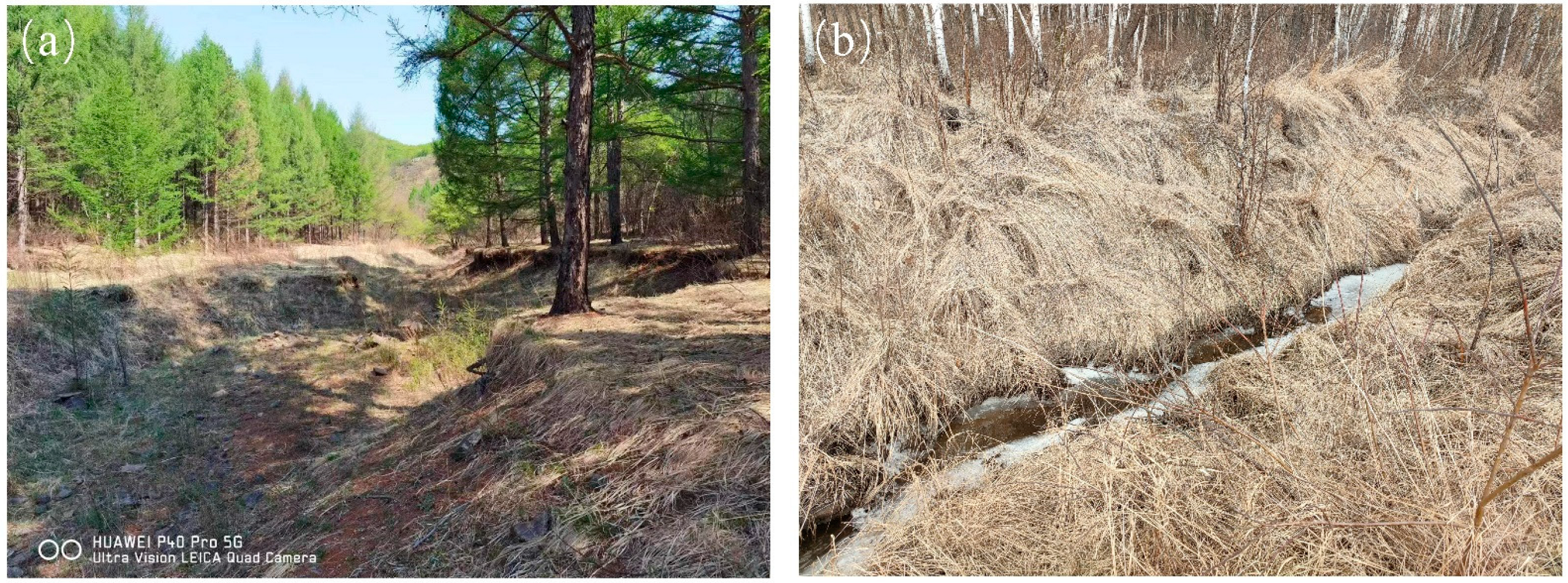
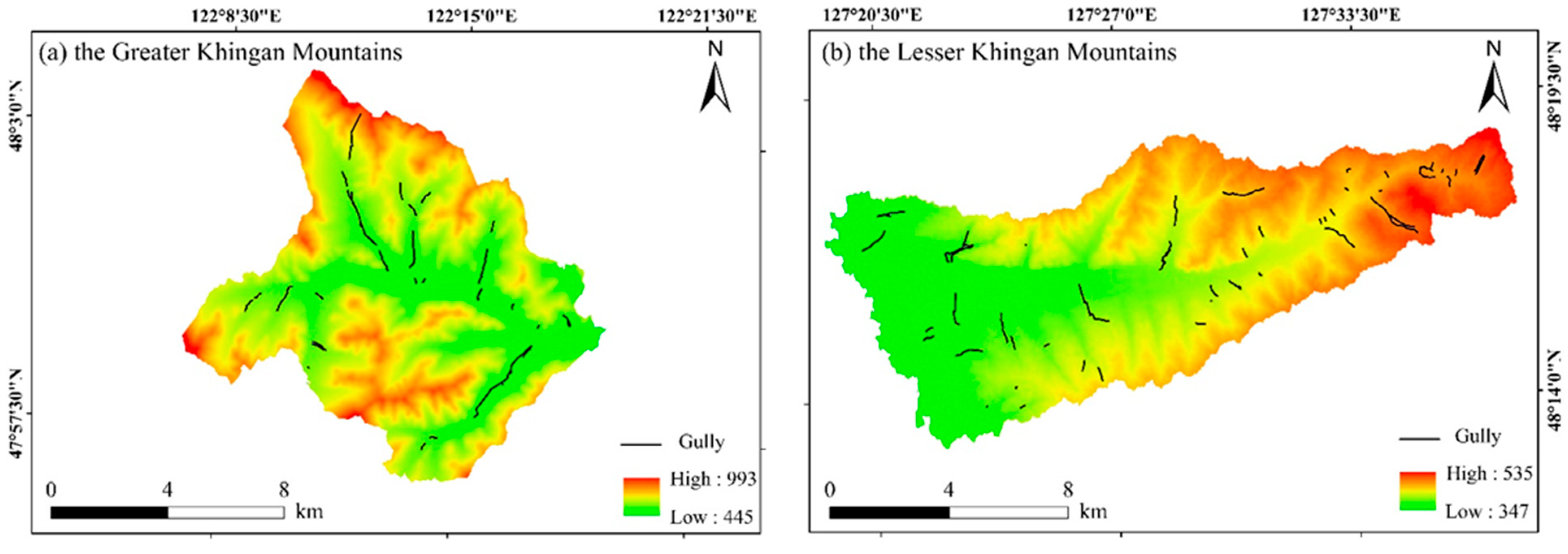


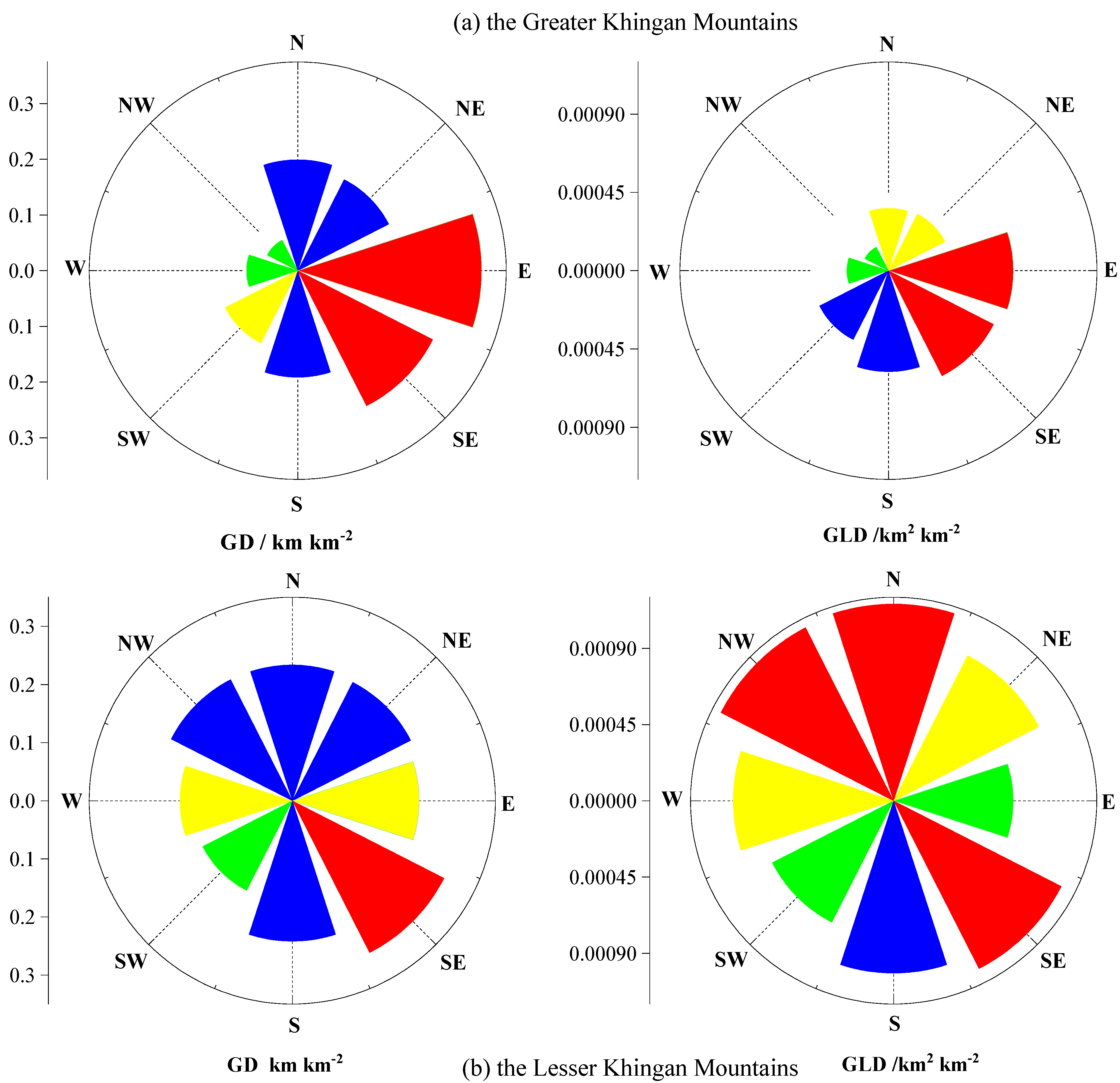
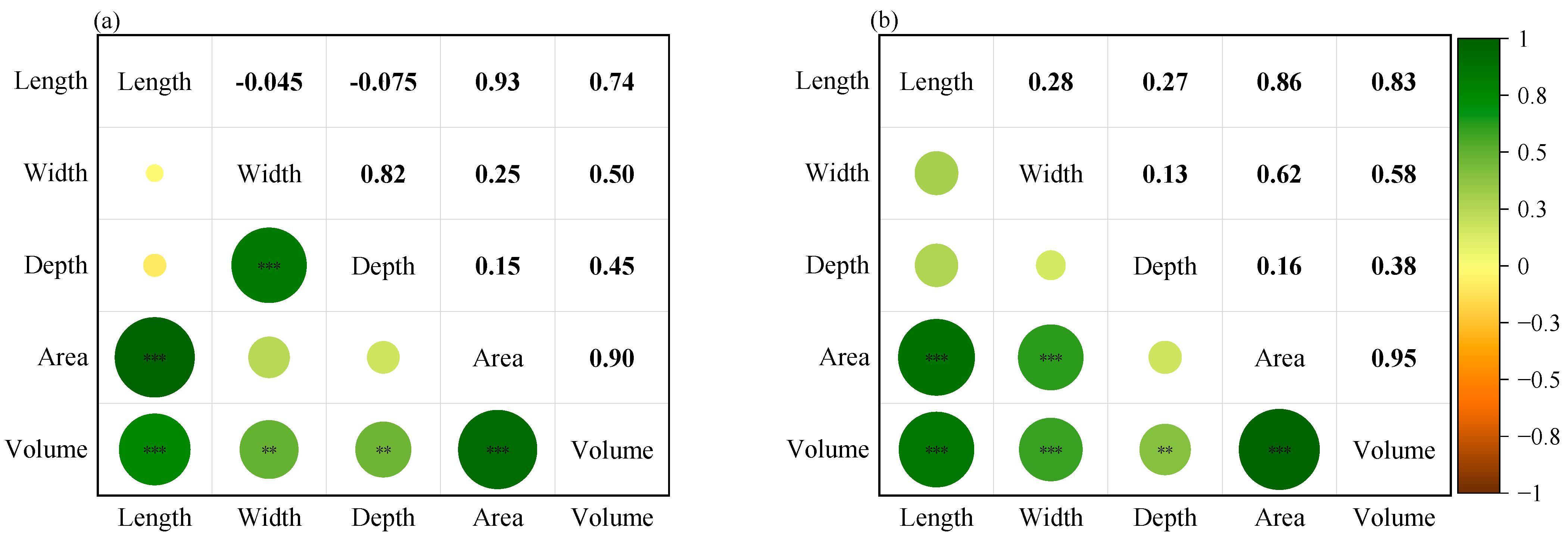

| Parameters | The Great Khingan Mountains | The Lesser Khingan Mountains |
|---|---|---|
| Vegetation cover | 67% | 91% |
| Gravel content | 27% | 52% |
| Average shape | 11.8° | 3.6° |
| Average temperature | 2.7 °C | 0.8 °C |
| Average rainfall | 500 mm | 566 mm |
| Soil texture | Clay | Loam |
| Parameters | The Great Khingan Mountains | The Lesser Khingan Mountains |
|---|---|---|
| Study area (km2) | 114.87 | 124.45 |
| Average length (m) | 524.42 | 560.13 |
| Average width (m) | 2.45 | 3.93 |
| Average depth (m) | 1.09 | 1.79 |
| Average area (km2) | 1243.93 | 2445.94 |
| Average volume (m3) | 1153.18 | 3365.55 |
| f (gully km−2) | 0.32 | 0.40 |
| GD (km/km−2) | 0.12 | 0.12 |
| GLD (km2/km−2) | 0.05 | 0.03 |
| Study Area | Average Length (m) | Average Width (m) | Average Depth (m) |
|---|---|---|---|
| The Greater Khingan mountains | 524.5 | 2.5 | 1.1 |
| The Lesser Khingan mountains | 560.1 | 3.9 | 1.8 |
| Rolling hilly region in northeast China [27] | 522.32 | 15.05 | 2.77 |
| Mountainous and hilly region of northeast China [19] | 81.9 | 5.3 | 1.05 |
| Loess plateau [28] | 58.4 | 9.0 | 6.2 |
| Yuanmou dry–hot Valley in Southwestern China [29] | 62.92 | 18.69 | - |
| The upper Blue Nile basin, Ethiopia [30] | 138.25 | 5.5 | 2.4 |
| The Lake Manyara basin, northern Tanzania [31] | 283.54 | 65.6 | 1.21 |
| Study Area | Volume Estimation Model |
|---|---|
| The Greater Khingan Mountains | V = 0.37 A1.11, R2 = 0.94 RMSE = 31.48 |
| The Lesser Khingan Mountains | V = 0.32 A1.17, R2 = 0.94 RMSE = 26.84 |
| Rolling hilly region in Northeast China [27] | V = 2.96 A0.97, R2 = 0.85 |
| Mountainous and hilly region of Northeast China [28] | V = 0.18 A1.25, R2 = 0.90 |
| Loess Plateau [29] | V = 1.71 A1.14, R2 = 0.85 |
| Yuanmou dry–hot valley in Southwestern China [30] | V = 3.24 L1.27, R2 = 0.77 |
| The upper Blue Nile basin, Ethiopia [31] | V = 1.05 A1.15, R2 = 0.95 |
Disclaimer/Publisher’s Note: The statements, opinions and data contained in all publications are solely those of the individual author(s) and contributor(s) and not of MDPI and/or the editor(s). MDPI and/or the editor(s) disclaim responsibility for any injury to people or property resulting from any ideas, methods, instructions or products referred to in the content. |
© 2023 by the authors. Licensee MDPI, Basel, Switzerland. This article is an open access article distributed under the terms and conditions of the Creative Commons Attribution (CC BY) license (https://creativecommons.org/licenses/by/4.0/).
Share and Cite
Wan, Z.; Song, Q.; Wang, J.; Guo, M.; Liu, X.; Chen, Z.; Zhou, P.; Wan, P. Geometry Morphology and Distribution Characteristics of Permanent Gullies in the Greater and Lesser Khingan Mountains Forest Region of China. Sustainability 2023, 15, 12056. https://doi.org/10.3390/su151512056
Wan Z, Song Q, Wang J, Guo M, Liu X, Chen Z, Zhou P, Wan P. Geometry Morphology and Distribution Characteristics of Permanent Gullies in the Greater and Lesser Khingan Mountains Forest Region of China. Sustainability. 2023; 15(15):12056. https://doi.org/10.3390/su151512056
Chicago/Turabian StyleWan, Zhaokai, Qingchen Song, Jilin Wang, Mingming Guo, Xin Liu, Zhuoxin Chen, Pengchong Zhou, and Puqiang Wan. 2023. "Geometry Morphology and Distribution Characteristics of Permanent Gullies in the Greater and Lesser Khingan Mountains Forest Region of China" Sustainability 15, no. 15: 12056. https://doi.org/10.3390/su151512056
APA StyleWan, Z., Song, Q., Wang, J., Guo, M., Liu, X., Chen, Z., Zhou, P., & Wan, P. (2023). Geometry Morphology and Distribution Characteristics of Permanent Gullies in the Greater and Lesser Khingan Mountains Forest Region of China. Sustainability, 15(15), 12056. https://doi.org/10.3390/su151512056







